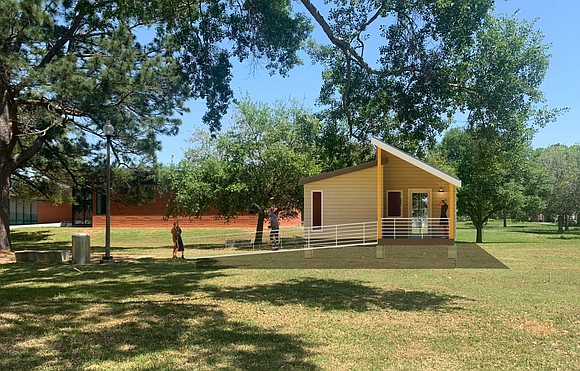PVAMU architecture students’ winning design could be a game-changer following natural disasters
Style Magazine Newswire | 6/7/2022, 3:15 p.m.
By Andrew Cohen
Seeking an alternative to FEMA trailers after the next climate catastrophe visits Houston’s historically segregated neighborhoods, students in the School of Architecture at Prairie View A&M University designed a single-family accessory dwelling unit that was selected as a winner in the student category of the City of Houston ADU|HOU Design Competition.
The concept, including renderings, floor plans and elevations, is featured in the online Accessory Dwelling Units – Houston Design Book, which presents 26 schematic designs from architecture students and firms from Houston and around the country.
“Prairie Dwelling 360/H House is hurricane ready and includes FEMA-fortified home building standards, as well as net-zero building assembly designs and renewable energy for our climate that will allow residents to maintain renewable energy if the utility grid goes down and students to continue to research through the prototype,” said Jessica April Ward, assistant professor at PVAMU.
According to Ward, two prototype versions of the winning ADU designed by PVAMU students will be built soon. Construction of an on-campus prototype, tentatively scheduled to begin this summer, will serve as potential housing for visiting lecturers and an energy-usage research opportunity for students.
Groundbreaking on a second version planned for as early as 2023 will partner Houston Habitat for Humanity with PVAMU through Ward’s Title III grant “Integrated Design for Environmental and Climate Justice Research.”
As Ward noted, other universities, such as Rice, which won several categories, including the Grand Prize, took part in the competition. Yet, the PVAMU student methodology in the development of the design established their ADU as a much-needed response to the periodic successive storms experienced along the Gulf Coast.
“I think what makes our project unique among other university student designs is the method,” Ward said. “Our students have been going into neighborhoods in Houston since 2015, before Hurricane Harvey. They began meeting with residents and community leaders to get critical feedback on their needs and on potential designs, participating in different planning department events.
“This was going on as some of these areas were struggling to recover from Hurricane Ike. In economically suppressed neighborhoods, how they recover from natural disasters is an ongoing conversation. The storms keep coming,” Ward said.
The country’s growing interest in ADUs—smaller, secondary housing options on a person’s private property—remains fueled by economics. However, Houston designers’ inclusion of the region’s weather patterns as a critical factor isn’t surprising.
The ADU|HOU Design Competition, funded by a 2021 AARP Community Challenge grant, is part of a broader conversation led by the City of Houston Planning & Development Department’s Livable Places Action Committee, which exists to encourage housing variety, affordability and equity.
The PVAMU students’ winning design pulled inspiration from other designs, the Double Barrel and Fly Flat, which won the U.S. Department of Energy’s Race to Net Zero competition and were recognized by the City of Houston and Texas Society of Architects. Ward said the students chose the initial “H” to denote the design’s origins in state-of-emergency shelters following devastating storms, such as hurricanes. The number “360” signifies the house’s original 360-square foot target, though the final design is a tad larger.
The design also highlights “Toward Regenerative Regionalism,” a focus in Ward’s studio class that encourages students to integrate a well-rounded approach to sustainable housing. Sustainable building has evolved into what people now call regenerative design. Students must consider regional climate, economics and architectural history as they solve problems through planning the built environment.
“In this way, the name refers to the full circle of the regenerative design loop,” Ward said. “Students achieve this when they talk to seniors to learn about the challenges they face after a storm, and the property achieves this when the family is able to rebuild and return home.”
Although informed by many conversations in Houston’s Fifth Ward, the final design responded to the needs of the homeowner still recovering from Harvey, who will one day inherit this second, smaller home on their property.
Comprising one bedroom and bath, a living room and a kitchen, the dwelling serves as a temporary home in place of a FEMA trailer or hotel and can remain in place as a second permanent residence for a family member or as a rental.
“This home is a demonstration prototype that we believe can be widely distributed,” Ward said, “It is meant to be replicable.”
It’s not a question of if hurricanes and floods will hit the Gulf Coast region, but when.
“Locally, we’re in between mega-disasters,” said Ward. As such, the ADUs must be easily and quickly assembled after a natural disaster so homeowners can immediately return to their damaged property.
Ward has hopes that a certain number of prototypes can be distributed and built before the next natural disaster so that ADUs can be tested and, if necessary, modified.
“You have to build it to figure out really what the cost is and test the durability of it, and then that will put us in a better position to keep pushing for the larger agenda,” Ward said. “The bigger conversation about ADUs has been happening in the city—things did progress more rapidly after Harvey—so this project was able to plug into that conversation, too.”
Many of Ward’s students have worked on this project, and she said that the feedback is always positive.
“With the help of our grant-funded research assistants, they’ve been able to carry this particular design through with consistency from semester to semester,” Ward said. “They do seem to light up when they’re able to go out into the field and have a real project. These projects take time to develop, and students matriculate. It’s a challenge, but I try to tell students it’s an opportunity to leave a legacy behind for the students who will follow.”









